Adriatic Sea
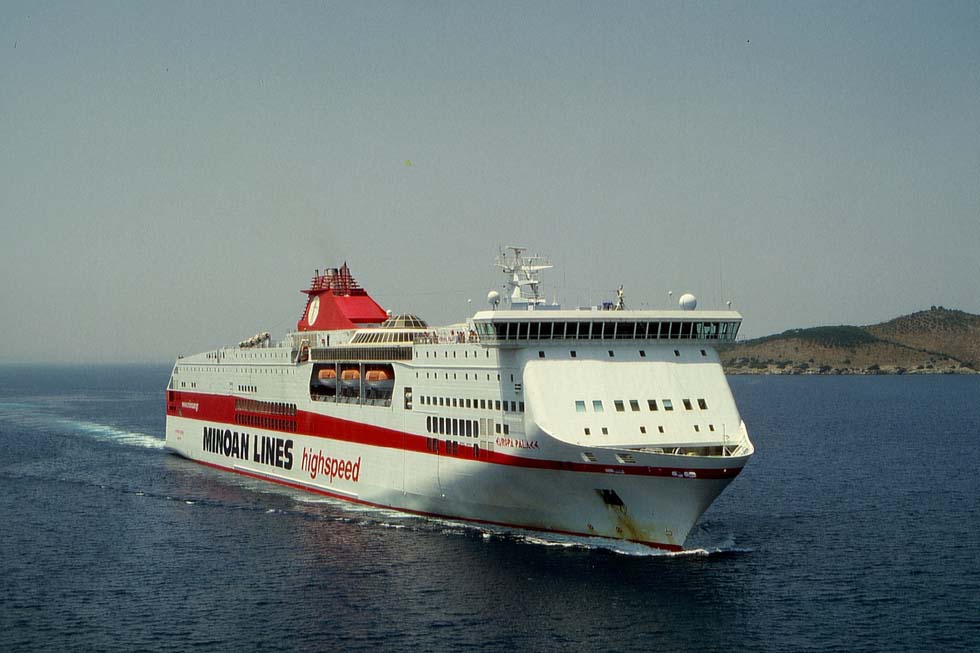
"Europa Palace" of Minoan Lines, near Igoumenitsa, Greece 2006 (WS)
Politically dominant was the conveyance of the British Indian Mail. A portion of the mail took the direct way France - Italy by rail via the Mont-Cenis for the first time in 1869, using the system Fell railway and from 1872 the Frejus tunnel. In France the railways were the Nord, the PLM and in Italy the Alta Italia and Meridionale, from 1885 Rete Mediterranea and Rete Adriatica, from 1905 the FS. At Brindisi the mails were taken over by the Societa Anonima Italiana di Navigazione Adriatico Orientale, founded by the Englishman Charles Hill in 1863. Four tiny steamers of 970 tons were put to work on the service to Alexandria. In 1870 the mail changed completely to the P&O - see main chapter Indian Ocean/ The P&O Empire and chapter Branch Lines/ Levant.
In the Habsburg Empire the Oesterreichischer Lloyd (Austrian Lloyd) was founded in 1835 as a joint-stock company. As founder, Karl von Bruck is honoured in Trieste. An immediate collapse was prevented by the Rothschild bankers of Vienna. When the 320-ton "Arciduca Lodovico", one of 6 paddle-wheelers built in England, left the San Carlo quay at Trieste on 16 May 1837, the route to Constantinople was opened, two weeks after the French had started their Constantinople service. Other services followed, connecting Trieste with Venice and, along the east coast, with Spalato (now Split), Ragusa (Dubrovnik), Cattaro in Herzegovina and with Durazzo (Durres) and Valona (Vlore) in Albania, liberated from the Osmans in 1912. A service by D. Trepcovich & Co was offered between Trieste and Ancona.
Trieste was the dominant harbour of the Habsburg Empire and Erzherzog Johann published already in 1825 the idea of connecting it by a railway. He pushed through the difficult route via the Semmering, thus avoiding the planned way through Hungary and in 1841 Emperor Ferdinand approved the project to be built as a state railway. Engineered by genius Carl Ghega, the Semmering railway together with the connecting Karst railway reached Trieste via Laibach in 1857. Completion was financed by the Rothschilds, who incorporated the line, together with their Lombard-Venetian and Central-Italian railways, into their Suedbahn. With the war of 1859 and foundation of the Kingdom of Italy in 1861, Habsburg lost most of its Italian provinces and, after the defeat against Prussia in 1866, also Venice. Their victory against the Italian fleet near Lissa was not helpful. France and England had recommended a sale, which the Rothschilds would have financed - in vain.
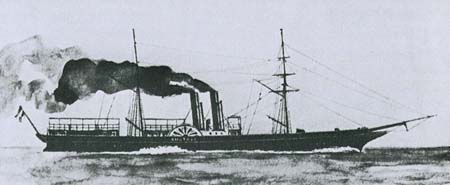
"Austria" of Oesterreichischer Lloyd (Technisches Museum, Vienna)
|
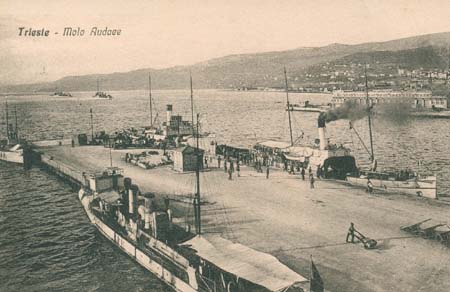
Trieste after WWI (old card, coll. WS)
|
Hungary, once liberated from the Osmans by the Habsburg Empire, got a privileged status in 1867. Fiume, now Rijeka in Croatia, was its port. Hungary established in the 19th century a shipping company, described by Cook's timetable as the Royal Hungarian Sea Navigation Co. , which offered services Fiume - Malta - Marseilles with a branch line Malta - Sicily. In connection with their steamer Fiume - Venice, Cook's of 1897 informed: "A train de luxe leaves Budapest Saturday and Tuesday". Maybe it was more important for nearby Abbazia, the noble spa, opened in 1884. From Fiume, Ungaro Croata maintained services to Patras in Greece and of course to Italy.
Services between Mediterranean and eastern Adriatic ports were offered by Adria and by other companies. At Venice the steamers of Navigazione Generale Italiana departed for Brindisi and Alexandria. Before WWI, Bradshaw's timetable listed the Societa Italiana di Servizi Marittimi and the Societa 'Puglia' with routes to Albania.
To Greece before WWI
Greece had its successful fight against the Sultan's rule and became an independent state under King Otto in 1832. The Greek harbour Piraeus was reached by the way round the rocky southern tips of the Peloponnese peninsula. On a shorter way, Oesterreichischer Lloyd connected Trieste with Athens by using an overland route via the Isthmus of Corinth. At that time, in the 1850's, a canal cutting the Isthmus had been put in consideration, but the costs appeared too high. Finally the canal was completed in 1893, 6km long and 22m wide. For a fast line ("Eillinie") Trieste - Piraeus - Constantinople (Istanbul), the "Bregenz", "Bruenn", Leopolis", "Linz", "Graz" and "Prag" were employed by Oesterreichischer Lloyd. Navigazione Generale Italiana operated a line Venice - Brindisi - Constantinople, Panhellenic Steam Navigation linked Trieste with Piraeus via Kalamata on the Peloponnese and temporarily the New Hellenic Steamship Company of Syros connected Brindisi with Piraeus. And there were the ships of Messageries Maritimes from Marseilles, calling at Piraeus.
In the early 20th century Societa Marittima Italiana as well as the Austrian and Greek steamers provided services Brindisi - Patras, with connection further on to Athens by the metre-gauge Peloponnese railway (SPAP), which had reached Patras in 1887. Fantastic proposals concerning the Indian Mail, e.g. for a railway from Vonitsa on the Adriatic Sea to Porto Rafti east of Athens, connecting with a steamer to Egypt, remained dreams. But in 1919, when the new de-luxe train Simplon-Orient-Express could not yet pass through to Istanbul, the Rome-Express from Paris connected for some months at Taranto in Italy with a steamer for Piraeus via Corinth and to the Bosporus.
World War I
The Habsburg Empire fought World War I on the side of German Emperor Wilhelm II, the loser. A state-owned strategic railway to Trieste, the Wocheinerbahn of 1906, commercially unimportant, carried the soldiers to the bloody Isonzo battlefield after Italy had entered war against Austria in 1915. As a reward it got the region of Trieste, Fiume and additionally Zara and other ports. The Habsburg Empire was dissolved and Austria lost access to the sea.
Between WWI and WWII
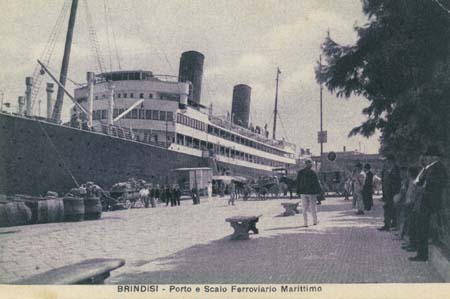
Italian ship at Brindisi (old card, coll. WS)
|
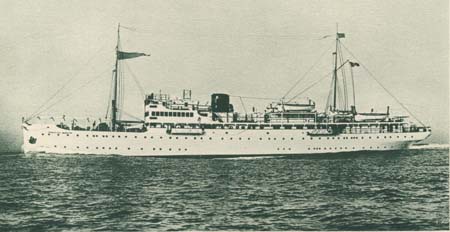
"Francesco Morosini", Espresso Dalmazia of San Marco SN (old card, coll. WS)
|
The Lloyd Triestino became the successor of Oesterreichischer Lloyd, but language aboard the ships did not change, reportedly it had always been Italian. Ports ceded to Italy were connected by Adria Line of Fiume and by San Marco SN, both Italian companies. Adria was incorporated into Tirrenia and with reorganization Adriatica took over in 1937 Eastern Mediterranean services from Lloyd Triestino, which concentrated on oceanic routes.
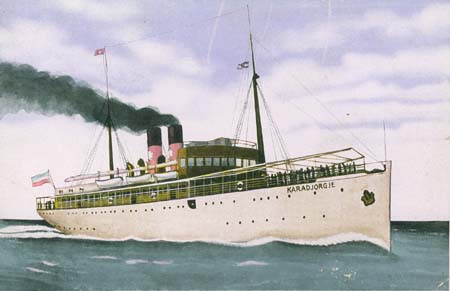 "Karadjordje" of Jadranska in the 1920s (old card, coll. WS)
"Karadjordje" of Jadranska in the 1920s (old card, coll. WS)
Serbia together with Croatia and Istria has formed the Kingdom of Yugoslavia, harassed by troubles among the provinces. The Jadranska Plovidba advertised its "Karadjorgje" as a saloon steamer departing from Susak, the Yugoslavian port neighbouring Fiume. And of course there were the various coastal services.
On the route to Greece, the ships of the National Steam Navigation Co. Ltd. of Greece, founded in 1908 by the Embiricos brothers, became dominant. Historian A.I. Tzamtzis mentioned e.g. for 1927 the National S.N. on a Marseilles - Piraeus - Istanbul route with the new "Patris II" (3,902 gt) of 1926 and the smaller "Andros" and "Syros" as well as the Ionian S.N.Co. on the Marseilles route with the "Attiki". The S.N. of Samos and also other Greek companies served Brindisi. The foreign companies connecting Greece were in 1926 (according to Tzamtzis) the P&O-owned Khedivial Mail Line, Messageries Maritimes, Fabre, Paquet, the Lloyd Triestino, Societa Italiana di Servici Marittimi, Puglia, Libera Triestino, the Zadranska Provioelba of Serbia as well as Bulgarian and Romanian enterprises.
In 1929 several Greek companies formed AKTEL. A timetable e.g. of 1934 listed their Brindisi services in cooperation with Epirotiki. By amalgamation with further companies, Hellenic Mediterranean Lines, abbreviated ELMES, was created in 1939.The National S.N.Co of Embiricos however has been dissolved in 1935.
Albania, its harbour Durres being connected mainly with Italy, was annexed by Italian forces under Mussolini in 1939. Italy started war on Greece in 1940. Then German troops conquered Yugoslavia and Greece in 1941 and genocide tortured the Balkan countries. In 1944 Yugoslavia regained sovereignty under Tito, who had his base at the island of Vis, the former Lissa..
To Greece after WWII
Since World War II the railway to Greece was blocked. British troops have protected Northern Greece from being conquered by the Soviets. Traveling home, they were conveyed by ship from Salonica (Thessaloniki) to bombed Piraeus and further on to Taranto, were they changed to the "Medloc" army trains. Only after the destroyed Vardar bridge in Macedonia was repaired in 1947, the Simplon-Orient-Express could reach Salonica, but not yet Athens. In 1949 Typaldos bought the "Princess Adelaide" (1910/ 3,061 gt) of the Canadian Pacific and introduced her, together with two consorts, on the Brindisi - Patras - Piraeus route. ELMES resumed services between Marseilles, Italy, Greece and the Levant. One of the three ships which had survived the war was the "Corinthia". The traditional Greek company Epirotiki Lines of the Potamianos family restarted Mediterranean services with the "Attiki" (ex "Killanrey" of Ireland). Also Nomikos with the "Miaulis" of only 1,800 tons was one of the early Greek providers of services to Italy. Then their steamers "Agamemnon" and "Achilleus" (5,500 gt) appeared on a Marseilles - Piraeus - Alexandria - Beirut route on behalf of Olympic Cruises.
Traditional Italian competitor was the Adriatica. After the war, in 1956, the company inaugurated on the Venice - Piraeus - Istanbul route the nice motor-ships "San Marco" and "San Giorgio" of 4,250 tons. The latter survived after several changes in ownership until the 21st century as "Royal Star" of African Safari Cruises.
Yugoslavia under Tito shook off the Soviet dominance in 1948. Rijeka (the former Fiume) has become its main harbour, while Trieste was protected by the Allies from being conquered. The Jadranska of Yugoslavia operated a route Venice - Dubrovnik - Piraeus. Linee Marittime Adriatico was listed in the late 60s with a car ferry route Ancona - Patras via Split in Yugoslavia. Neighbouring Albania remained at that time tightly isolated under dictator Enver Hoxha. Turkish Maritime Lines employed the steamers "Ankara" (6,210 gt) and "Adana" on a route Barcelona - Marseilles - Naples - Piraeus - Istanbul and "Ege" between Venice and Istanbul.
First Car Ferries to Greece
In 1959 Epirotiki had equipped the steamer "Atreus" with a garage. That was the first car-carrying service on the Brindisi - Patras route. Nea Epirotiki introduced the "Adria". In 1960/61 followed Epirotiki's first true car ferries, "Pegasus" and "Hermes", 5,251-ton steam ferries, built in 1930 for the Canadian Pacific. In 1960 Hellenic Mediterranean Lines ELMES or HML introduced the car ferry "Egnatia" on Brindisi services and then other companies followed. Efthymiadis Lines used the 10,000-ton "Phaistos", "Minos" and "Sophia", originally Swedish tankers, rebuilt in 1966. Typaldos refurbished in 1965 the "Warwickshire" (1948/ 8,903 gt) of Bibby Line to become the car-ferry "Hania" for services Greece - Italy.
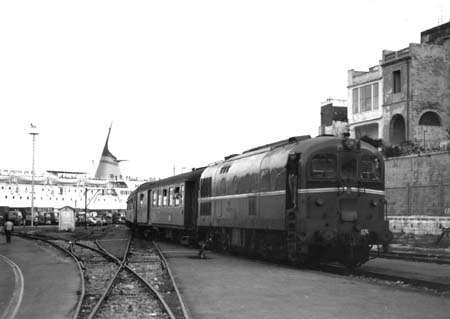
Brindidi Marittima, train from Paris and "Aquarius" of ELMES, 1978 (WS)
|
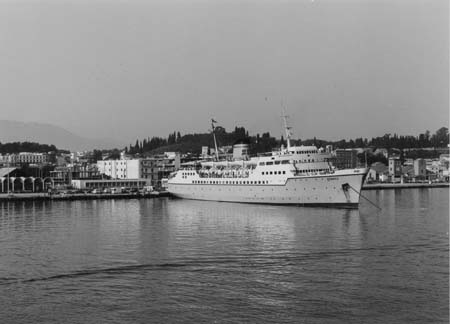
"Egnatia" of ELMES, Corfu 1978 (WS)
|
During the decades after WWII a multitude of Greek companies, car-carrying or not, have provided services, e.g. Adriatic Seaways, Chandris, Cross Ferry, Epirotiki, Efthymiadis, Fragline, Hellenic Italian Line, Ionian Lines, Karageorgis, Kavounides, Libra Maritime, Med-Sun Lines, New Epirotiki, Nomikos, Poseidon Lines, R Line, Strintzis, Toyias ... More than a dozen Greek shipping lines crossed the Adriatic, while Italian companies didn't compete, obviously caused by higher labour cost. After migrant workers' traffic grew, main competitors were the horribly crowded trains through Yugoslavia to Greece. According to the press, the Greek government had prevented new ferry services in order to support money-losing Olympic Airways, until 1974 owned by Aristoteles Onassis. Also financing the introduction of an up-to-date "Akropolis" train Munich - Athens was stopped by the Greek government. Brindisi was connected by some modest regular trains with Germany and even with Paris. Chaotic Brindisi port became so crowded, that a well-known German weekly warned to use that harbour. Everyday thousands of passengers had to pass through a tiny office room to get their passports controlled, tickets were stolen and a leading journalist of Associated Press is convinced that the theft of his new motorcar days after ferrying was arranged by some Brindisi "mafia" - possibly reasons for the traffic change to Ancona.
Karageorgis Lines employed in the '60s, '70s and '80s on the Ancona route the ferries MS "Mediterranean Sky" and her sister "Mediterranean Sea", yellow/white and strikingly streamlined. Indeed they were rebuilt old vessels. The "Mediterranean Sky" had been the "City of York" (14,941 gt) of Ellerman Lines, built in 1953. Laid up in the Bay of Elefsina, she stranded and capsized in 2002. In the '70s for some years Trans-Tirreno of Italy connected Corinth with the "Espresso Corinto". Until 1985, HML cooperated with Adriatica. A variety of small companies connected always Corfu and the Ionian islands with the Greek mainland.
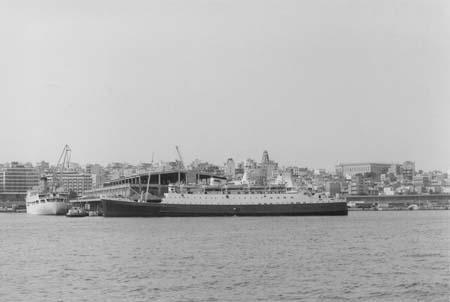
"Aphrodite" of Med Sun Lines, Piraeus 1982 (WS)
|
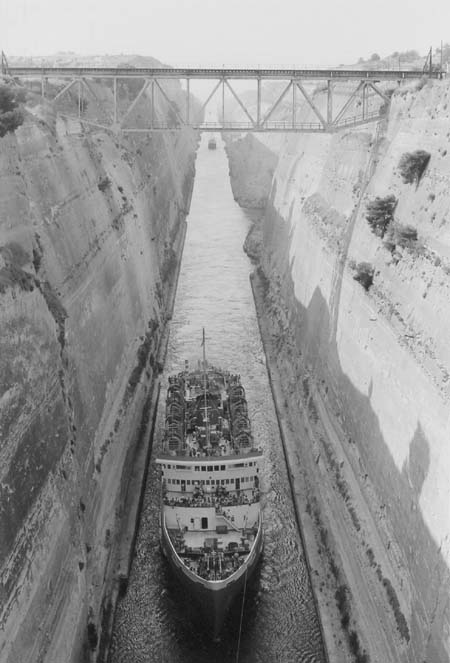
"Orpheus" of Epirotiki/ Swans, Canal of Corinth with Peloponnese railway bridge, 1980 (WS)
|
Other Ferry Routes
Services along the coast of Yugoslavia were continued by Jadranska, then by Jadrolinija. In the late 50s the timetable listed express services Venice - Croatia and Venice - Piraeus with the 2,600-ton motor-ships "Jugoslavia" and "Jadran" and also local steamer services by Jadranska Line of Yugoslavia. Later a route Venice - Piraeus - Beirut - Istanbul was operated with the new "Dalmacija". The ABC Shipping Guide listed towards the end of the 70s car ferry services between Italy and Yugoslavia by Jadrolinija, Losinjska Plovidba, Prekookeanska Plovidba, Linee Marittime dell' Adriatico and Navigazione Alto Adriatico.
Mediterranean European Seaways, Med Link Lines, Med Sun Lines, Turkish Maritime Lines and Sanline maintained services from Ancona or Brindisi to Turkey at least temporarily. In the early 90s, a service Ancona - Piraeus - Kusadasi via the Corinth canal was tried by Minoan Lines with the "Ariadne" (ex "Tor Hollandia" of 1967), but it was closed down after a few months. Marmara Lines of Turkey continued to offer a seasonal service from Brindisi to Cesme in Turkey, but in 2011 it was reported (via Wikipedia) being "suspended". A quite different clientele had been targeted by James B. Sherwood, owner of the Sea Containers Group, with his "Orient Express" - see chapter Levant.
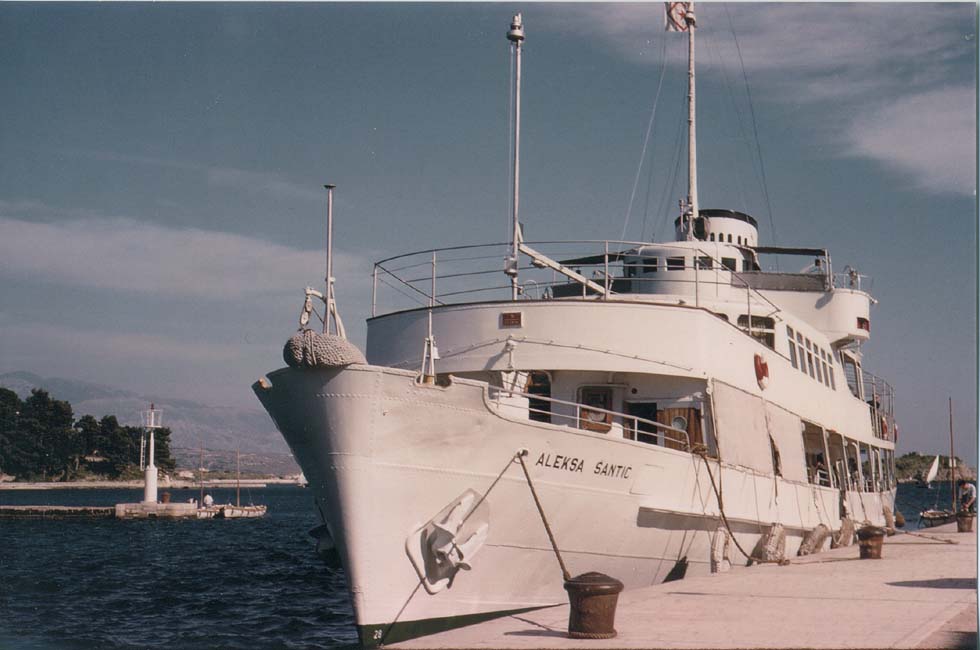
"Aleksa Santic" of Jadranska, Gyor 1960 (HSch)
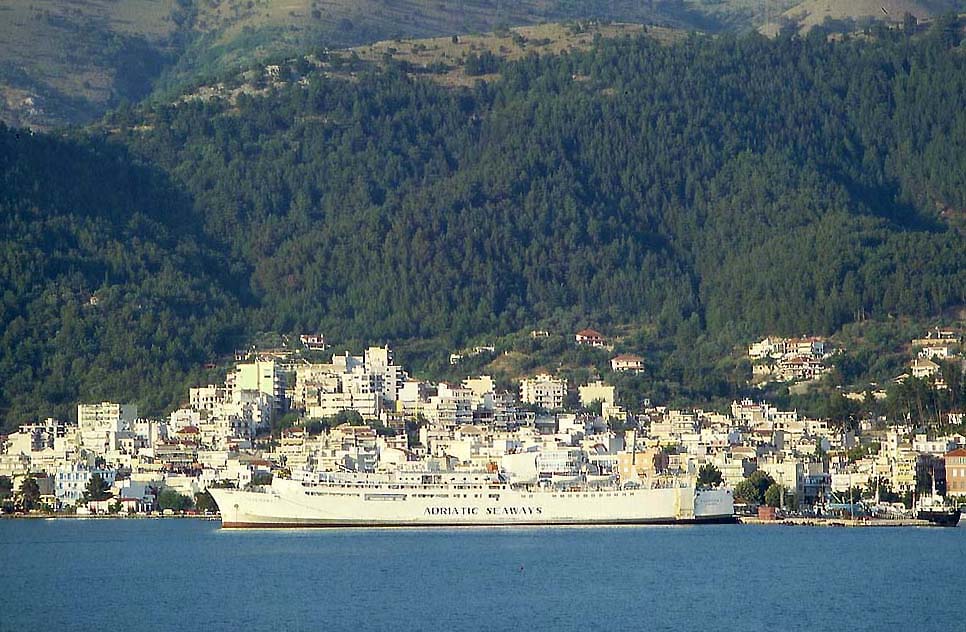
"Poseidon C" of Adriatic Seaways, ex "Poseidon" of Med Link Lines (ex "Suzaran Maru"), Igoumenitsa 2005 (WS)
New East Coast Ferries
Yugoslavia's leader Tito died in 1980 and a decade after, in 1991, the autonomous provinces separated, a bloody war was started and much truck traffic to Turkey took the way via Italy, Igoumenitsa and Greece. After the wars, Yugoslavia was split up completely. Jadrolinija of Croatia continued Adriatic services. Also Aliscafi/SNAV, Adriatica, Tirrenia and roughly a dozen other companies appeared on routes to or from Croatia. The InCat catamaran "Hoverspeed Belgium" of 1992 (later "Hoverspeed Boulogne", "Seacat Danmark") entered in 2004 Split services as "Pescara Jet" for SNAV/Seacat, a joint-venture between Hoverspeed, owned by the Sea Containers Group, and MSC-owner Gianluigi Aponte. In 2006 Sea Containers filed for insolvency and had to retire from SNAV/Seacat. Then the timetable showed Aponte-owned SNAV with the hi-speed "Croazia Jet". Blue Line, a part of the Superfast Group, introduced in 2003 on the Ancona - Split route the white/blue "Ancona" (1966/7,883 gt), the former "Svea" of Svenska Lloyd. Azzura Line and Montenegro Lines connected Italy with Bar in Montenegro. And there were other companies coming and going.
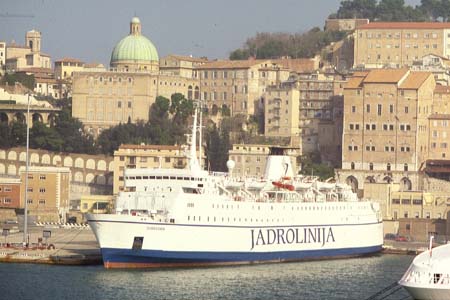
"Dubrovnik" of Jadrolinija, Ancona 2009 (WS)
|
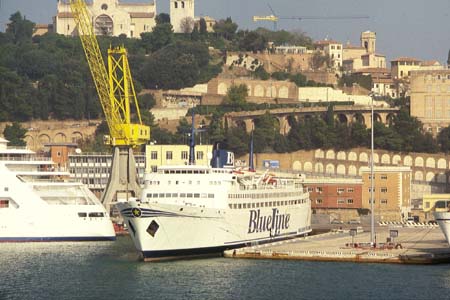
"Ancona" of Blue Line (ex "Svea"), Ancona 2009 (WS)
|
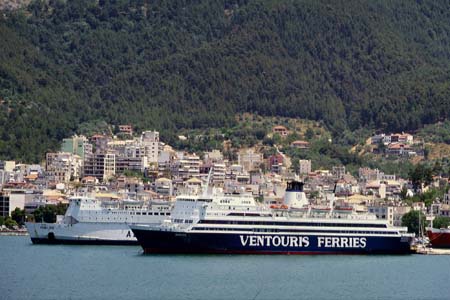
"Rigel" of Ventouris and "Penelope" of Agoudimos, Igoumenitsa 2009 (WS)
|
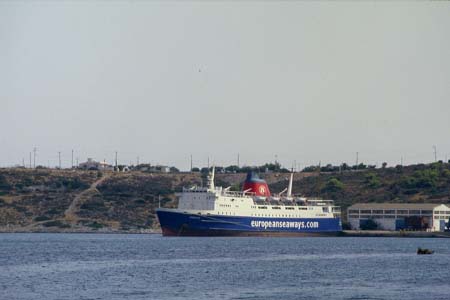
"Apollon" (the former "Senlac"), Salamis 2010 (WS)
|
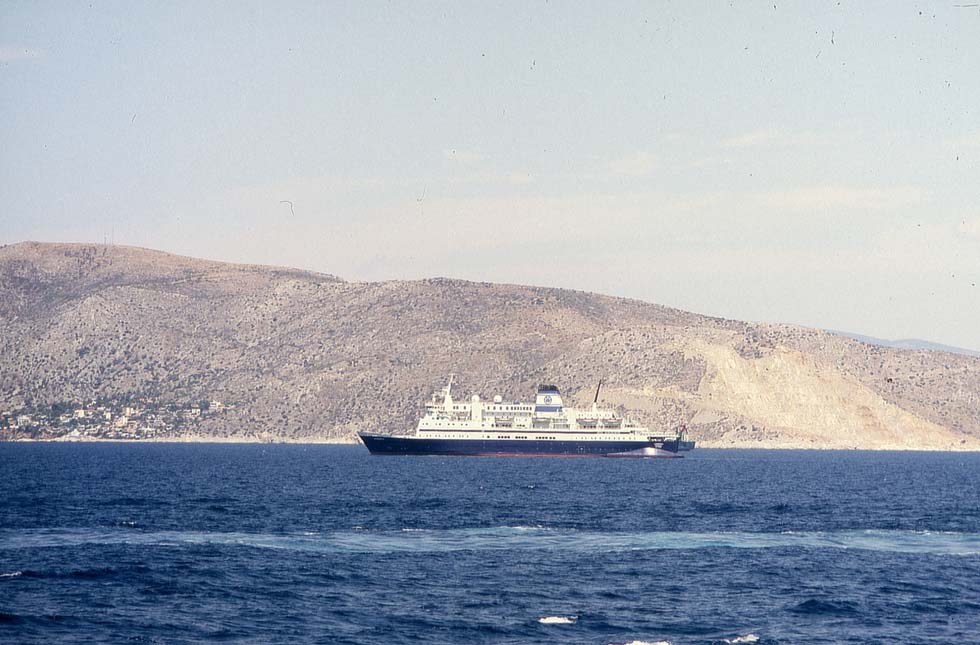
The former "Bore Star", temporarily "Orient Express", then "Arberia", near Salamis in 2009 (WS)
Albania got rid of communist tyranny in 1990, but unrest harassed the country still in the 90s. Among the dozen shipping companies appearing and vanishing from services from Italy to Durres in Albania after liberation was also the traditional Tirrenia with the "Egitto Express". Ventouris Ferries of George Ventouris could be watched further on, e.g. with the "Rigel", the former "Bore I" of Silja Line. Also other enterprises started Durres services, such as Arkoumanis with the "Apollon" (the former "Senlac" of SeaLink), then labeled European Seaways. In 2009 Ilion Lines introduced the "Arberia", the former "Bore Star" of 1975, temporarily Sherwood's "Orient Express", on Durres services, in late 2011 reported being "suspended". Also Adria Ferries of Italy was listed by the press with second-hand ferries on the Ancona - Durres route. Skenderbeg Linesappeared on the route Brindisi - Vlore, Albania.
The Race across the Adriatic
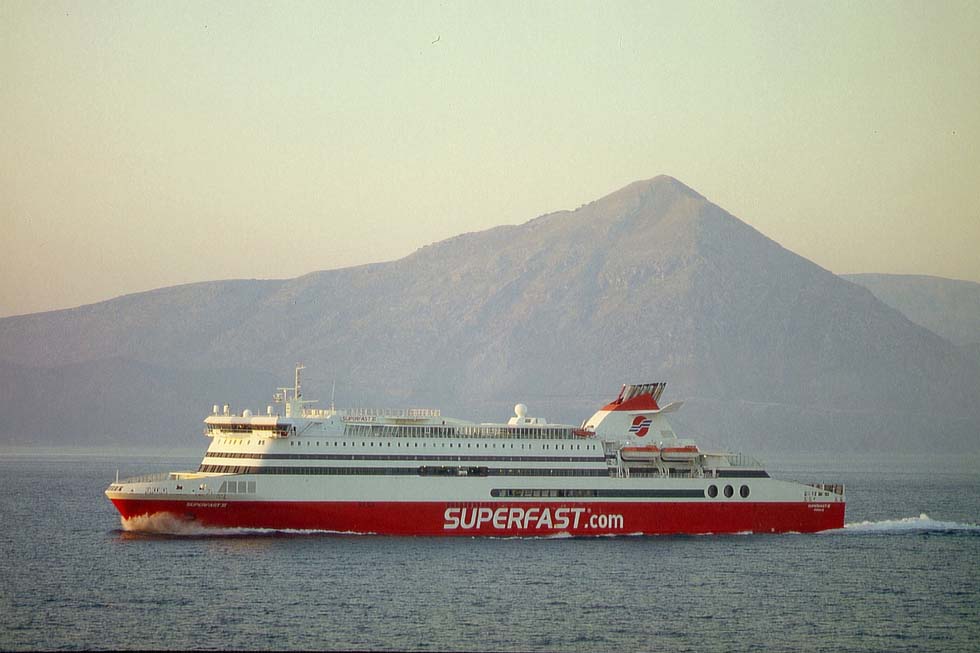
"Superfast XI" after departure from Patras, 2007 (WS)
Modern car ferries started to connect mainly Ancona, Bari and Venice with Igumenitsa, Corfu and Patras, while the way to Greece by road has become unpopular since the Yugoslavian wars. Direct passenger trains have vanished completely. Traditional HML services disappeared after its "Egnatia III" (ex "Stena Scandinavia" of 1973) was chartered out to Algerie Ferries in 2004. Minoan Lines of Crete had opened Ancona - Patras services in 1981 with the "El Greco", originally the "Ferry Atsuta" of Japan, then joined by other second-hand ships. ANEK, also of Crete, started Adriatic services in 1989 with the "Lissos" and "Lato", both bought from Japan. In 1992 followed the "El. Venizelos", one of the four ships commissioned by Stena Line in Poland (completed in 1992 at Perama) on the route Trieste - Patras.
There had also been initiatives to introduce true hi-speeds on services Italy - Greece. For some time Aliscafi and HML had a cooperation for connecting Brindisi with Corfu within only 4 1/2 hours by the "Ali Jumbo". In 1996 the MDV1200 type monohull was delivered from Fincantieri, developed by the Greek-Italian consortium Ocean Bridge Development for services Italy - Greece. The fascinating appearance of these hi-speeds was a work of Pininfarina. However, the first one, the "Pegasus One" (1996/ 3,971 gt), was chartered out as "Stena Pegasus" for Newhaven - Dieppe services, was also used by Conferry of Venezuela as "Margarita Express", by Tallink as "Autoexpress 4" and finally found its way to Greece as "Speedrunner II" - see chapter Aegean. The "Pegasus Two" was registered for Shannon Alexis, became the Tallink "Autoexpress 3" and went to the Red Sea. Then for a short period the Austal-built catamaran "Highspeed 4" of a Minoan-owned HSW-predecessor was employed on a Patras - Italy service.
As on the relatively long routes hi-speeds are not competitive with airlines, it was quite logic that the "race across the Adriatic" continued with conventional ferries. In 2005 the new unsuitable harbour of Trieste was abandoned by ANEK (it is not known if hostile polls, experienced in Trieste, were the reason). The "El. Venizelos", with 38,261 tons too big and with 22 knots relatively slow, was leased out to Cotunav of Tunesia. ANEK with the "Levka Ori" and Sophocles V." of 29,378 tons (built in Japan for Higashi Nippon Ferries) changed to Venice. Also Minoan Lines with the Korean-built trio "Prometheus" (2001/ 26,995 gt, 30 knots), "Oceanus" and "Ariadne Palace" (then sold to Grimaldi Lines, Corsica Sardinia Ferries resp. Moby Lines) and the pair "Ikarus Palace" and "Pasiphae Palace" (1998/ 30,018 gt, built in Norway) served the Venice route and replaced the ferries of the cooperating Strintzis Line. Agoudimos Lines and Endeavour Lines struggled for survival with second-hand ferries from Japan.
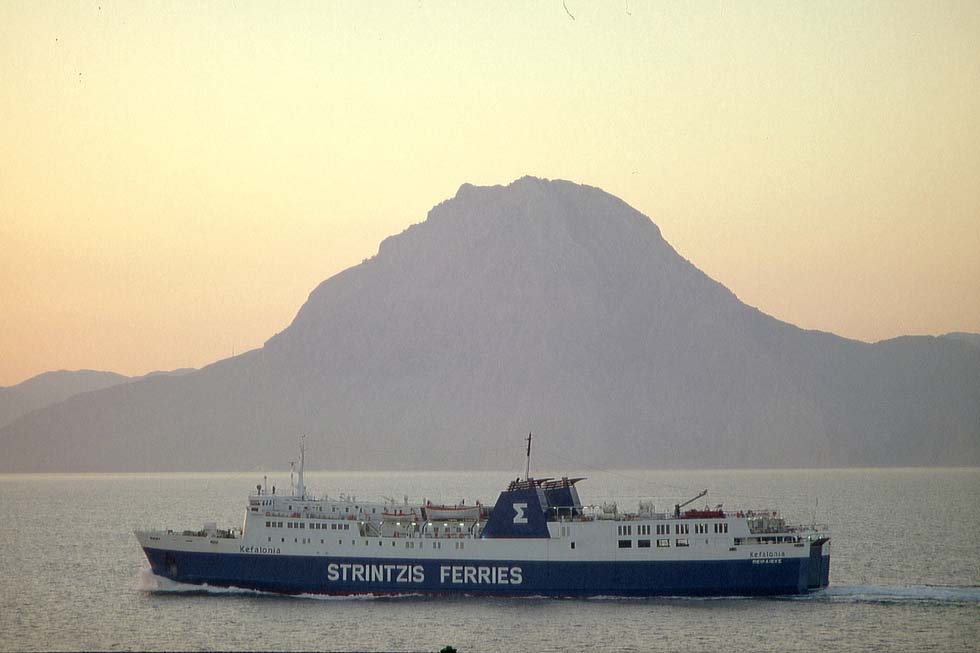
"Kefalonia" leaving Patras, 2007 (WS)
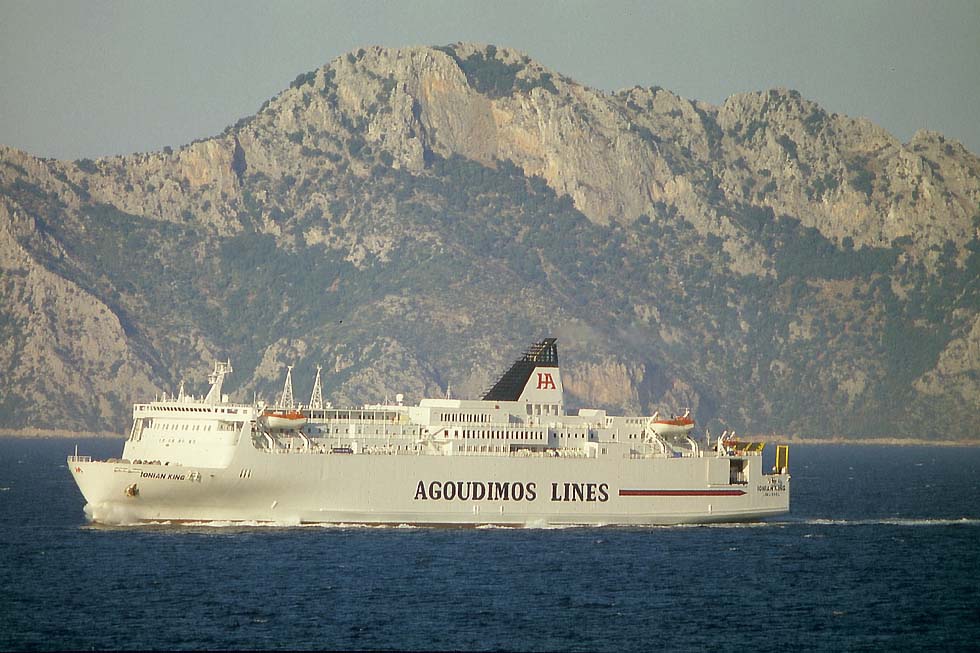
"Ionian King" (ex "Ferry Lavender" of Shin Nihonkai), 2007 (WS)
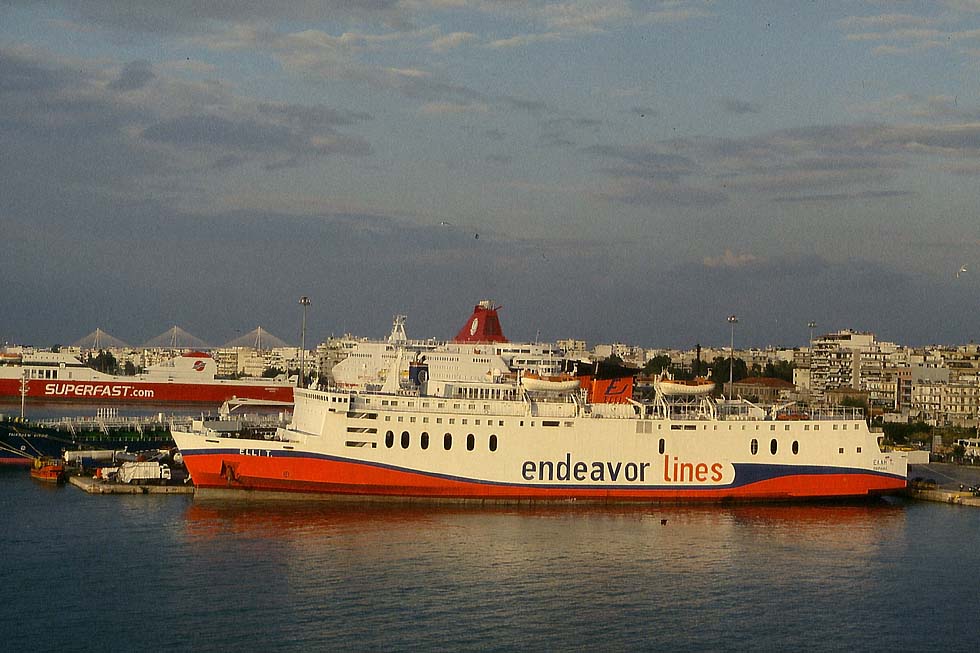
"Elli T.", Patras 2009 (WS)
On the Ancona - Patras route, Minoan introduced in 1995 the "Aretousa", sister of "Ikarus Palace", covering the distance in 22 hours with a speed up to 27 knots. In the same year 1995 however Superfast Ferries, founded by Pericles Panagopoulos, became the champion. He sold in 1989 his Royal Cruise Line to the Kloster Group, by this way changing to the ferry business. The striking red/white "Superfast I" and II of 1995 were the first ferries to offer a traveling time of only 20 hours. In the meantime "Superfast XI" and "XII" (2002/ 30,902 gt), built for a speed of 31.5 knots, were introduced, like all their modern predecessors built in Germany. A deal led to replacement of Strintzis by Superfast's partner Blue Star Ferries, which introduced in 2000 the "Blue Star 1" and "2" (29,415 gt) on the Ancona - Patras route, then used in the Aegean. Minoan bounced back with the "Olympia Palace" and "Europa Palace" (2001/02/ 36,825 gt), like their two sisters of the Crete route built in Genoa for a speed up to 31.6 knots - and Italian investors held a share in Minoan! Third competitor is ANEK with the equally fast "Hellenic Spririt" and "Olympic Champion" (2002/ 32,694 gt) built in Norway, two ships only and thus commercially less risky. ANEK chartered in 2007 for one season the "Jean Nicoli" (2002/30,285 gt, ex "Superfast X") of SNCM. Superfast Ferries, together with Blue Star via Attica Holding sold to the Marfin Investment Group (MIG) of Emirates investors, took over 2 slower 26,760-ton ro-pax vessels, commissioned by Grandi Navi Veloci, thus starting in 2009 to change to more economic vessels on the Bari route. Under an agreement with ANEK, both companies employed e.g. in 2011 on the prestigious Ancona route the "Superfast VI", "Superfast XII" and "Olympic Champion".
The expanding Grimaldi Group Naples started a cooperation with Hellenic Seaways, then Minoan-owned, in the ro-ro business. In 2007-08 Grimaldi finally acquired Minoan Lines. It resulted in the announcement of acquisition of 2 new ferries (already commissioned by Grimaldi) for Patras - Ancona, each equipped for transportation of 180 trucks and a maximum of 3,000 passengers, 1,257 in cabin berths. Their Italian-flagged "Cruise Europa" (sister of Grimaldi's 54,310-ton "Cruise Roma"), capable of a speed of 28 knots, entered service on the Ancona - Patras route in autumn 2009, followed in 2010 by sister "Cruise Olympia". Not only their size, but also their cool modern interior design is fascinating. The splendid "Europa Palace" and "Olympia Palace" replaced the smaller ships on the Venice route. With these activities of Emanuele Grimaldi, Italy started to re-conquer the Adriatic Sea trade, which had been lost to the Greek. In Patras the new southern port was opened in 2011, despite crisis and strikes.
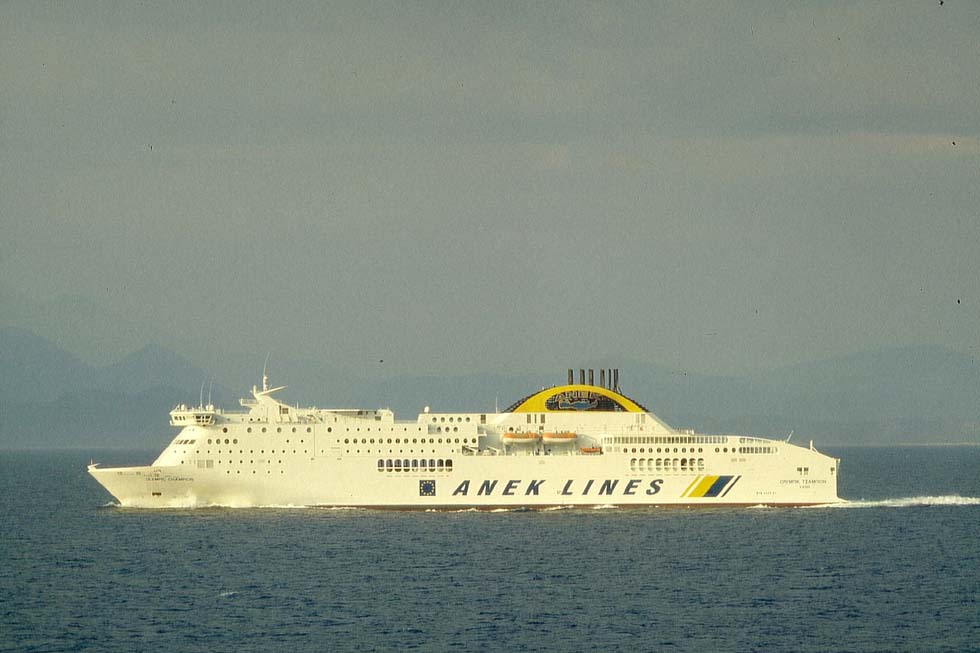
"Olympic Champion" after departure from Patras, 2009 (WS)
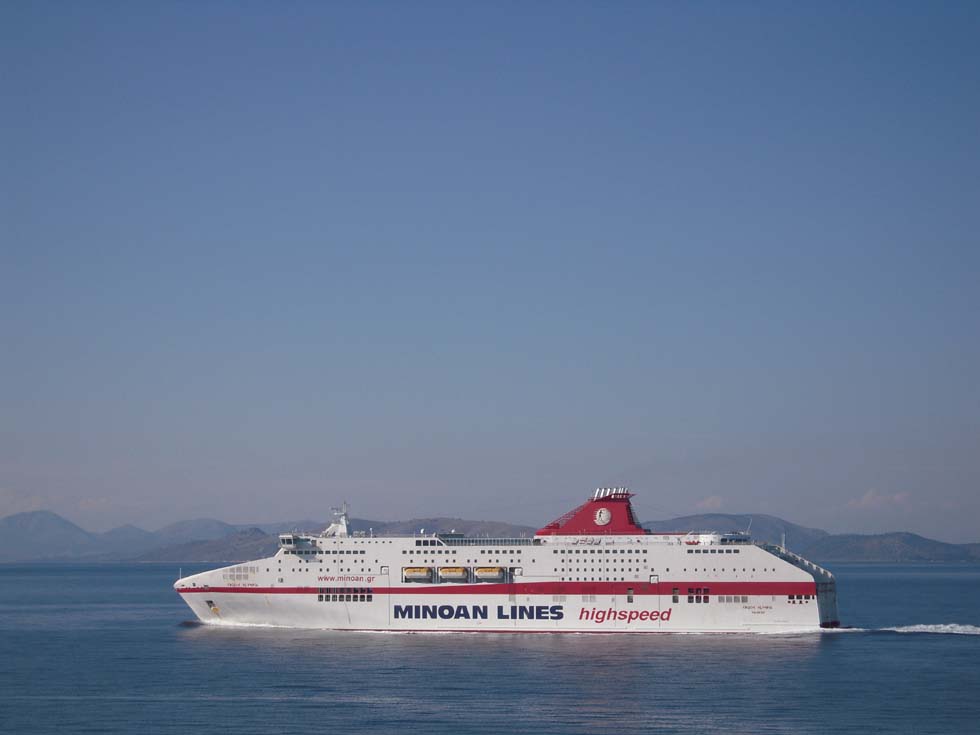
"Cruise Olympia" off the Greek coast near Corfu, 2011 (WS)
|